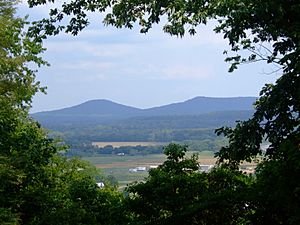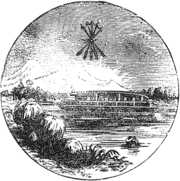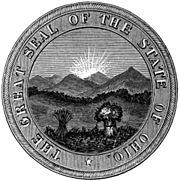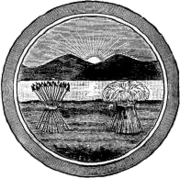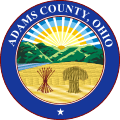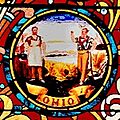Seal of Ohio facts for kids
Quick facts for kids Seal of Ohio |
|
|---|---|
 |
|
| Versions | |
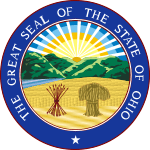
An imitation of the Artist's Version
|
|
| Armiger | State of Ohio |
| Adopted | 1996 (current form) |
| Earlier version(s) | Many, starting 1803 |
| Use | State government offices and letterheads, driver's licenses |
The Great Seal of the State of Ohio is the official symbol of the U.S. state of Ohio. It's like Ohio's special badge! You can see it on many official things. All government offices, agencies, and courts in Ohio use different versions of this state seal.
The main part of the seal is a round picture. It shows a sunrise over Chillicothe, which was Ohio's very first capital city. The seal also includes symbols that tell the story of how Ohio began. Sometimes, the state motto, "With God, all things are possible", is also shown with the seal.
Ohio first adopted a seal in 1803, soon after it became a state. This first design was based on a drawing by Secretary of State William Creighton, Jr.. For a long time, the seal's look wasn't very strict. But in 1967, a standard design was finally created. The seal was last changed in 1996 to its current look.
Every one of Ohio's 88 counties also has its own official seal. These county seals are all based on the main state seal.
Contents
What Does the Ohio Seal Look Like?
| Coat of arms of the State of Ohio | |
|---|---|
 |
|
| Armiger | State of Ohio |
| Adopted | 1953 (current form in 1996) |
| Use | State and local government offices, older license plates |
The design of the Great Seal of Ohio is described in Ohio's laws. The seal is about two and a half inches wide. Inside it, there's a smaller circle that holds the "coat of arms" of the state. Around this inner circle, you'll see the words "THE GREAT SEAL OF THE STATE OF OHIO".
The coat of arms itself has several important parts:
- Wheat and Arrows: On the right side, there's a full bundle of wheat. On the left, there are seventeen arrows tied together. The wheat stands for Ohio's farming and rich land. The seventeen arrows show that Ohio was the 17th state to join the United States.
- Mount Logan: In the background, you can see a picture of Mount Logan. This mountain is in Ross County, and the view is from a place called Adena state memorial.
- Rising Sun: Above the mountain, a sun is rising. About three-quarters of the sun is showing. It has thirteen rays of light shining out. These thirteen rays stand for the original thirteen colonies of the United States. The sun shining over Mount Logan shows that Ohio was the first state created in the Northwest Territory.
- River and Fields: Connecting the front and back parts of the picture, you can see the Scioto River and fields where crops are grown. This shows Ohio's natural beauty and its farming heritage.
When the coat of arms is shown in color, the colors are meant to look like the real colors of the land and objects in the picture. The hills shown in the seal are part of Great Seal State Park, which is managed by the Department of Natural Resources.
Ohio Seal History: How It Changed Over Time
Ohio's state seal has been changed many times throughout its history. For a long time, from 1805 to 1866, the design of the seal wasn't officially written down anywhere. This was unusual compared to other states.
Early Seals: Before Ohio Was a State

Motto: Meliorem lapsa locavit ("He has planted one better than the one fallen")
Before Ohio became a state, the area was called the Northwest Territory. This territory had its own seal. The U.S. government created this seal for official papers. It had a Latin saying, Meliorem lapsa locavit, which means "He has planted one better than the one fallen." This motto celebrated how the wild land was becoming a place for people to live.
The First State Seal: The Rising Sun
When Ohio became a state in 1803, its first constitution said there would be a state seal, but it didn't say what it should look like. The first Secretary of State, William Creighton, Jr., used his own personal seal at first.
On March 25, 1803, Ohio's lawmakers passed a bill that described the first official state seal. It was based on Creighton's drawing. The design included a bundle of wheat, seventeen arrows, a mountain, and a rising sun. The words "The great seal of the state of Ohio" were to go around it.
People often say that this design shows the view from Senator Thomas Worthington's estate near Chillicothe, called Adena. The story goes that Creighton saw the sun rising over Mount Logan there and thought it looked like the "rising sun of the new state." Today, the seal officially represents the view from Adena.
Many Designs and Changes
After 1805, the law that described the seal's design was removed. This meant there was no official rule for what the seal should look like. Because of this, many different versions of the seal appeared over the years. Some added a plow, a different kind of boat on a river, or more mountains. One version even showed a canal boat!
In 1866, lawmakers tried to make the seal much more detailed and fancy. They added figures of a farmer and a blacksmith, a train, and a steamboat. They also added a Latin motto, "Imperium in Imperio". This motto meant "a state within a state," which was a strange choice right after the American Civil War, as it sounded like states were trying to be separate from the main country. This complex design was also very expensive to make.
Because of the motto and the cost, a new group of lawmakers changed the seal back in 1868. They returned to a simpler design, much like the original 1803 seal, but they officially included the mountain range and river. Even so, the fancy 1866 design was still used on some documents and buildings for many years.
Making the Seal Standard
On December 15, 1967, the coat of arms was officially updated. This happened because an artist was painting the seal in the Ohio Statehouse and wasn't sure which version to use! So, lawmakers decided to create one standard design for all state government uses. The river was brought back into the design, and the sun had seventeen rays. It was also officially stated that the scene showed the view from Adena.
The law said that all new seals made after January 1, 1969, had to use this new design. This rule also applied to county and city governments.
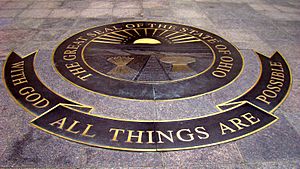
The most recent change to the seal happened on November 20, 1996. The number of sun rays was changed from seventeen to thirteen. This was done to represent the original thirteen colonies of the United States. The lawmakers thought that the number seventeen was already shown by the bundle of seventeen arrows. State agencies were given until March 1, 2003 (Ohio's 200th birthday) to update their seals. There were also attempts to add the Wright Flyer (the first airplane) to the seal, but these ideas did not pass.
How the Ohio Seal is Used Today
The Ohio Revised Code, which is Ohio's law book, says that the seals of all "state, county, and municipal agencies, divisions, boards and commissions" must have the state coat of arms. It also says exactly what words should be around the coat of arms for different courts and elected officials. Even notaries public (people who can legally witness signatures) must use the state coat of arms on their seals.
The state coat of arms is also in the middle of the flag of the Governor of Ohio. This flag design was first used in 1905 and became official in 1945.
From 2004 to 2010, the state's official coat of arms was a big part of the "Sunburst" license plate design. Since 2021, the full-color "Artist's Version" of the seal also appears on the "Sunrise in Ohio" license plate design.
Different Versions of the Seal
-
Seal of the Governor of Ohio
-
Seal of the Ohio House of Representatives
-
Seal of the Ohio Senate
-
Seal of the City of Hubbard
-
Seal of the City of Portsmouth
-
Seal of the City of Youngstown
-
Seal of Adams County
-
Seal of Columbiana County
-
Seal of Fairfield County
-
Seal of Franklin County
-
Seal of Guernsey County
-
Seal of Hamilton County
-
Seal of Hancock County
-
Seal of Highland County
-
Seal of Mahoning County
-
Seal of Ross County
-
Seal of Warren County
Images for kids
-
A stained-glass 1866 seal originally hung in 1889 in the San Diego County Superior Courthouse.
See also
 In Spanish: Gran sello del estado de Ohio para niños
In Spanish: Gran sello del estado de Ohio para niños


